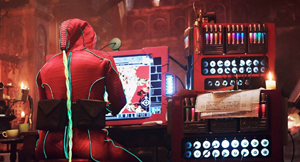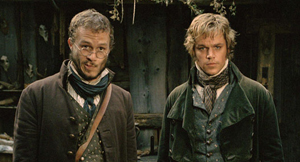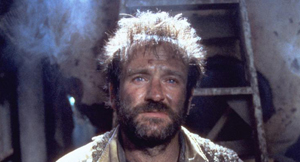On this page we have photos and details of how the Munchausen special effects unit constructed and filmed the sea monster models. This work was performed in Pinewood – after the decision was made to take the special effects production from Rome’s Cinecitta studios to London, where it was felt that Gilliam and team could have more control. Richard Conway was the film’s head of special effects, and is quoted below.

Scenes of the principal actors treading water were shot in a swimming pool at Cinecitta. However, when Sally spies a distant island which frighteningly reveals itself to be the back of a giant sea monster, the sequence shifted to the giant water tank on Pinewood’s 007 stage.
Richard Conway: The sea monster was our largest miniature. It was built around a four-wheel drive Land Rover from which we had removed the engine and most of the body. We refitted it with our own hydraulic motor and hydraulic umbilical cords and then anchored a big scissors lift on top. The lift was fixed onto the bottom of the fish. The vehicle was submerged in the tank – but through the umbilical lines we could drive it all around, just like an ordinary car.”
The sea monster was sculpted and detailed by Keith Short, working from designs provided by Terry Gilliam. The model’s functional interior consisted of a steel animated armature with a fibreglass core, and its skin was composed of solid latex sheets.
Richard Conway: The sea monster had all sorts of capabilities. The eyes and mouth could open and move, and a big fin on its back could open up – all through hydraulic controls. For the shot where it starts out as an island, rises up and comes rushing towards the camera, we raised the fish up on the big scissors lift underneath the water and then just drove it toward the camera with its mouth opening and closing. Right below the water line we had added a number of fish tails and air jets to boil up the water as the monster moved by. We also used a CO2 fire extinguisher inside the model to make it look as though it were spouting like a whale. It took four people to simultaneously operate all this.
Richard Conway: The jaws were a separate sectionalized model about ten feet across. They were independently operated off hydraulic feed lines, and could open and close while still in the water. Our biggest problem was moving them fast enough. Since we were shooting high speed, we had to get the jaws up, closed and down again within about two seconds – and all through an enormously resistant amount of water. We had to make twin hollows inside that we could pump full of air and thus force out the water. We had a box-steel scissors type of hydraulic arrangement underneath to push the jaws up and out of the water. The stresses were enormous. Having to move that much water as quickly as we did really ripped the scissors apart. We bent every inch of metal on that thing.
















